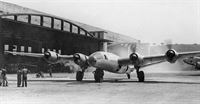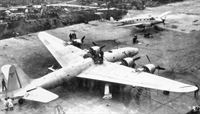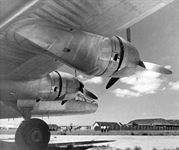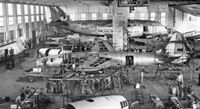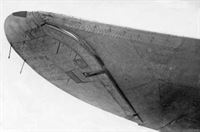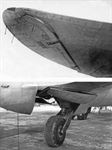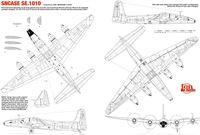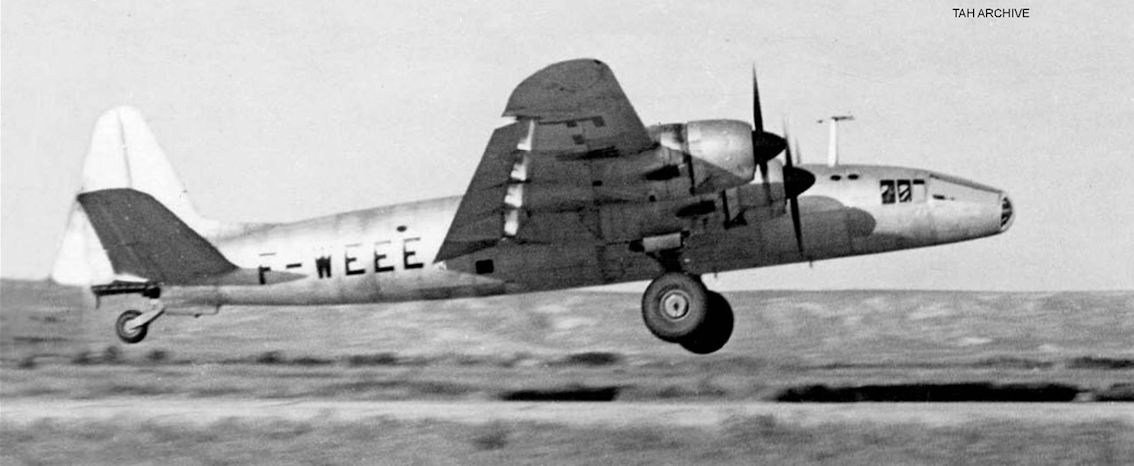
Описание
Страна : Франция
Год : 1948
Единственный экземпляр
Long-range monoplane for photographic or general transport duties
Sud-Est. Опытные военные самолеты
<...>
Еще одним интересным с технической точки зрения проектом был высотный фоторазведчик S.E.1010. Первый полет он выполнил 24 ноября 1948 года. На прототипе стояли четыре звездообразных мотора 14R-28/29 мощностью по 1590 л. с. Во время одного из испытательных полетов в октябре 1949 года самолет свалился в плоский штопор и разбился. Программу разработки закрыли.
- Описание
Фотографии
-
Aviation Historian 25 / J.Mesnard - Tragique The Sud-Est SE.1010
Регистрационный номер: F-WEEE [16] Still fitted with its original shorter fin and with registration F-WEEE applied, the SE.1010 makes its first short hops at Marignane on June 29, 1948, in the hands of test pilot Jacques Lecarme. At the time, Lecarme had only recently converted on the de Havilland Vampire, which was to be manufactured under licence by SNCASE.
-
Мировая Авиация 242
Регистрационный номер: F-WEEE [16] F-WEEE - единственный прототип S.E.1010. Размах крыла составлял 31,00 м, максимальная взлетная масса 24 000 кг.
-
Aviation Historian 25 / J.Mesnard - Tragique The Sud-Est SE.1010
Регистрационный номер: F-WEEE [16] The SE. 1010 photographed from the LeO 453 accompanying it on its ill-fated last flight, on October 1, 1949. Shortly after this was taken, the pair separated and the SE.1010 undertook asymmetric power tests. The tragic result was a flat spin into a vineyard. Note the taller revised fin.
-
Aviation Historian 25 / J.Mesnard - Tragique The Sud-Est SE.1010
Регистрационный номер: F-WEEE [16] The sole SE.1010, F-WEEE, displays its sleek lines during its extensive trials programme in 1948-49.
-
Aviation Historian 25 / J.Mesnard - Tragique The Sud-Est SE.1010
Регистрационный номер: F-WEEE [16] Bearing the number “25” on its forward fuselage, F-WEEE is inspected by members of the public at the 18th Salon de l’Aeronautique at Paris in May 1949. According to British weekly Flight, the type “contrasted with the more corpulent transports”present; the magazine also noted its Mercier ailerons, “the effectiveness of which was convincingly demonstrated by large roll-angles without visible trace of slewing or directional deviation”.
-
Aviation Historian 25 / J.Mesnard - Tragique The Sud-Est SE.1010
Регистрационный номер: F-WEEE [16] Engineers look on as the prototype’s 14R engines are run outside the distinctive hangar at Marignane in early 1948. The 14R radial was originally a product of the Gnome-Rhone company, which was nationalised in August 1945 to become the Societe Nationale d’Etudes et de Construction de Moteurs d’Aviation (SNECMA).
-
Aviation Historian 25 / J.Mesnard - Tragique The Sud-Est SE.1010
Регистрационный номер: F-WEEE [16] The prototype undergoes undercarriage-retraction tests on the ramp at Marignane. Although a large aircraft, with a span equal to that of an Avro Lancaster, the SE.1010 was designed to be operable from relatively small semi-prepared airfields, and would have carried a spare main wheel and tail wheel as standard equipment.
-
Aviation Historian 25 / J.Mesnard - Tragique The Sud-Est SE.1010
Регистрационный номер: F-WEEE [16] Yet to have its registration applied to fuselage and wings, the SE.1010 undergoes maintenance alongside Nord NC.702 F-BBFR at Marignane some time before its first short hops in June 1948.
Другие самолёты на фотографии: Siebel Si.204 - Германия - 1941
-
Aviation Historian 25 / J.Mesnard - Tragique The Sud-Est SE.1010
Регистрационный номер: F-WEEE [16] The SE.1010 at the SNCASE airfield at Marignane, near Marseille. Like many post-war French aircraft, the SE.1010 gave the lie to the old adage “if it looks right, it flies right”.
-
Aviation Historian 25 / J.Mesnard - Tragique The Sud-Est SE.1010
Регистрационный номер: F-WEEE [16] The prototype SE.1010 under construction in the Marignane hangar on January 20, 1948. In the foreground is the fuselage of one of the two production examples, neither of which was ever completed; in the background is the fourth SE.200 Amphitrite six-engined flying-boat, which was also never completed and was ultimately scrapped.
Другие самолёты на фотографии: Sud-Est SE.200 - Франция - 1943
-
Aviation Historian 25 / J.Mesnard - Tragique The Sud-Est SE.1010
Регистрационный номер: F-WEEE [16] The two SE.1011s in the assembly hall at Marignane on February 28, 1950. Note the revised, shorter "drooped B-29" nose section fitted to the central airframe, just visible at the far right of the photograph. Neither of these two “production models” was ultimately completed, and the programme was cancelled shortly afterwards.
-
Aviation Historian 25 / J.Mesnard - Tragique The Sud-Est SE.1010
Регистрационный номер: F-WEEE [16] In order to provide as good a performance as possible from short semi-prepared airfields, the SE.1010 incorporated flaps along the trailing edge of the 16 per cent thickness-to-chord-ratio wings.
-
Aviation Historian 27
Регистрационный номер: F-WEEE [16] Ailerons don’t come stranger than Mercier - both in principle and in practice on the SNCASE SE.1010.
-
Aviation Historian 25 / J.Mesnard - Tragique The Sud-Est SE.1010
Регистрационный номер: F-WEEE [16] TOP The SE.1010’s unusual Mercier ailerons were fitted to the tips of the wings, allowing the flaps to run the entire length of the trailing edge.
BOTTOM The tailwheel doors were articulated, with a fold in the door when in the wheel-down position, to allow full travel of the elevators on the low-set tailplane. -
Aviation Historian 25 / J.Mesnard - Tragique The Sud-Est SE.1010
Регистрационный номер: F-WEEE [16] The SE.1010 undertook asymmetric power tests. The tragic result was a flat spin into a vineyard, the aftermath of which is seen here.
-
Aviation Historian 36
Регистрационный номер: F-WEEE [16] We love it when TAH articles (in this case Tragique: The Sud-Est SE.1010 in TAH 25) spark modelling projects. This photo came from Derbyshire subscriber David Hart: “Like many of my models, this is a ‘kit bash’ of the old school (think mid-’60s Airfix Mag). The fuselage owes something to a 1/100th-scale Tamiya Ilyushin Il-28 and Milliput filler. The wings started life as part of a 1/144th-scale B-17 from Crown; the engine nacelles started as part of a Minicraft KC-97, while the propellers are white-metal items from Welsh Models, intended for an Avro York. I see this as very much a sketch of the aircraft; I am visibly not a rivet-counter”. Merveilleuse!
-
Aviation Historian 25 / J.Mesnard - Tragique The Sud-Est SE.1010
SNCASE SE.1010. Characterised especially by its long glazed nose and the unconventional Mercier ailerons fitted to its elegantly upswept wingtips, the SE.1010 was of normal all-metal construction with a circular-section pressurised cabin
- Фотографии





